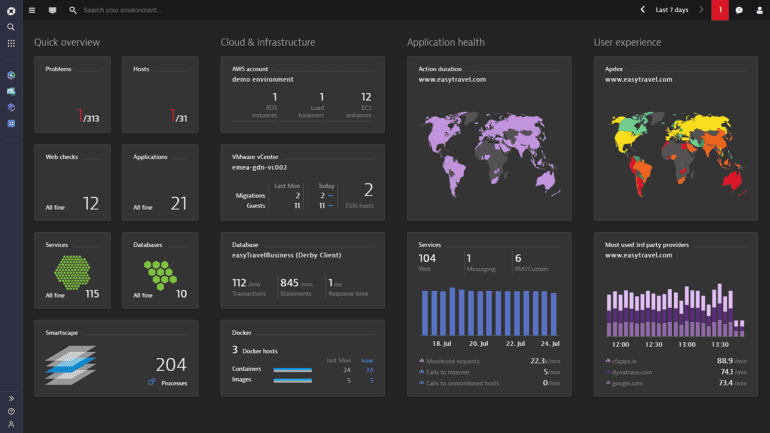TL;DR:
- Dynatrace integrates generative AI into its Davis AI engine, offering customers a third mode of AI for natural language capabilities in dashboard creation, workflow automation, and task completion.
- The combination of generative AI, causal AI, and predictive AI empowers IT teams to swiftly identify trends and predict performance issues.
- Generative AI streamlines communication with the AI engine, making the product more accessible to a broader audience and reducing the time required for complex system analysis.
- The popularity of generative AI presents an opportunity for observability vendors to incorporate cutting-edge technology into their platforms.
- Dynatrace’s expanded Davis AI engine will be available to customers in 2023, revolutionizing the industry’s observability standards.
Main AI News:
In a bid to bolster its observability platform, Dynatrace has taken a groundbreaking leap by integrating generative AI into its Davis AI engine. This innovative addition empowers customers with the ability to swiftly create interactive dashboards, discern the root cause of incidents, and significantly accelerate the mean time to repair.
The existing Davis AI already boasts causal and predictive capabilities. Now, with the incorporation of generative AI, Dynatrace unlocks a new realm of possibilities, offering customers a third dimension of AI. This mode seamlessly applies natural language capabilities, facilitating the creation of intuitive dashboards, automated workflows, and efficient task completion.
The collaboration between Davis CoPilot generative AI and the causal AI technology, which analyzes real-time data, along with the Davis predictive AI models that anticipate future behavior based on historical data and observed patterns, constitutes a trifecta of AI prowess. This trifecta enables Dynatrace to scrutinize billions of dependencies within systems, unravel predictive insights, comprehend connections, and effectively respond to complex queries.
Alois Reitbauer, the chief technology strategist at Dynatrace, emphasized the significance of generative AI in making the product accessible to a broader audience. By facilitating custom workflows without necessitating code-writing, human operators take the lead, albeit with substantial time savings. Reitbauer envisions generative AI as an indispensable tool that efficiently processes the vast system information and promptly guides it to the relevant teams.
The amalgamation of these AI technologies empowers IT teams to rapidly identify behavioral trends and preemptively address potential performance issues that could adversely affect end-users and customer experiences with applications, a competitive advantage that Dynatrace proudly asserts.
Gregg Siegfried, vice president and research analyst at Gartner, recognizes the synergistic harmony that emerges from the three styles of AI in Davis. Notably, generative AI’s inherent linguistic capabilities provide a more human-like interaction style, facilitating seamless communication between operators and the AI engine.
Dynatrace’s robust platform vigilantly monitors numerous components in an environment to meticulously track application performance metrics, such as response time and latency. The strategic application of AI and automation in this monitoring process stems from the overwhelming volume of data and metrics involved, surpassing human capabilities. By leveraging Davis, IT teams benefit from timely guidance and insights when applications encounter performance issues, ensuring they avoid unnecessary detours in their problem-solving journey.
Generative AI’s popularity surge may prove instrumental in shaping how customers implement AI in their environments. It presents a golden opportunity for observability vendors, including Dynatrace’s competitors like New Relic, Riverbed, and Splunk, to integrate this cutting-edge technology into their platforms.
As John-David Lovelock, distinguished VP analyst at Gartner, points out, generative AI’s natural pathway to the market lies within existing software, hardware, and services. With annual feature additions and upgrades, enterprises can gradually incorporate generative AI into their IT budgets, embracing its full potential.
In the calendar year 2023, the expanded Dynatrace Davis AI engine will be unleashed, elevating the platform to unprecedented heights. By offering this core technology in both on-premises and software-as-a-service (SaaS) models, Dynatrace aims to revolutionize the industry, setting new standards for observability and AI integration. This bold step towards a more intelligent future promises to redefine the way businesses monitor and optimize their digital landscapes.
Conclusion:
Dynatrace’s incorporation of generative AI marks a significant advancement in the observability market. By offering a third dimension of AI, with natural language capabilities, the platform enhances its accessibility and accelerates problem-solving processes. This innovative approach allows businesses to leverage AI-driven insights effectively, gaining a competitive edge in today’s fast-paced digital landscape. Observability vendors should take note of the growing demand for generative AI and explore its integration into their offerings to meet customer expectations and stay ahead in the market.

